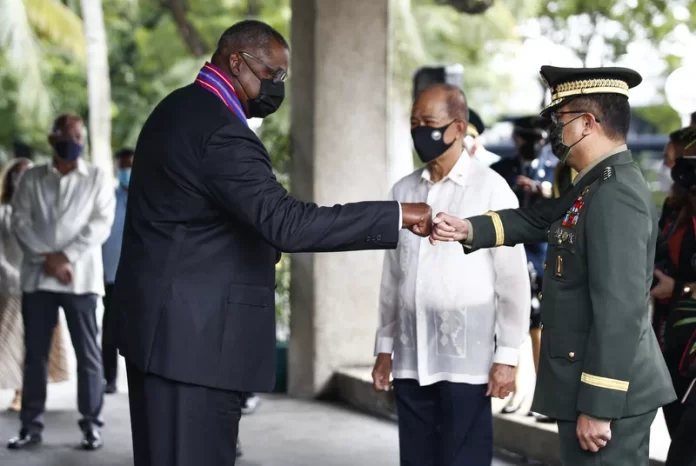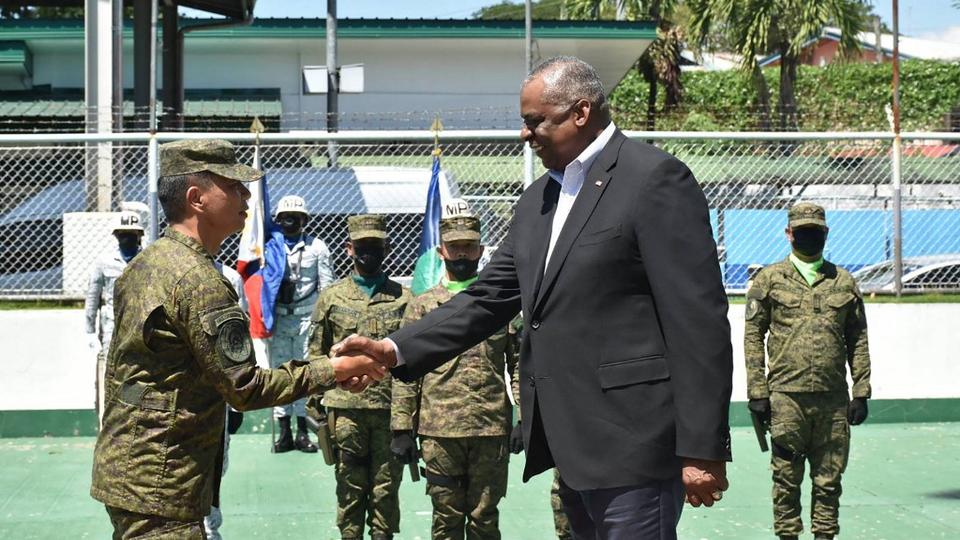Washington is reportedly seeking access to more bases in the Southeast Asian nation’s western coast facing the South China Sea and in northern Luzon across the sea from the Taiwan Strait.
US Defence Secretary Lloyd Austin is in the Philippines for talks about deploying additional American forces and weapons in more Filipino military camps, a sensitive issue for its long-time Southeast Asian ally that once hosted the largest US naval and air bases in the world outside of the United States.
Austin flew in from South Korea, where he said the US would also increase its deployment of advanced weapons, such as fighter jets and bombers, to the Korean Peninsula to bolster joint training with South Korean forces in response to North Korea’s growing nuclear threat.
In the Philippines, Washington’s oldest treaty ally in Asia and a key front in the US battle against terrorism, Austin visited on Wednesday the southern city of Zamboanga and met Filipino generals and a small contingent of US counterterrorism forces based in a military camp in Mindanao island, regional Philippine military commander Lt Gen Roy Galido said.
“Our working relationship with them is very strong,” Galido was quoted as telling reporters. He said that US troops would also help in humanitarian and disaster response missions.
The more than 100 US military personnel have provided intelligence and combat advice for years to Filipino troops battling a decades-long separatist insurgency, which has considerably eased but remains a security threat.
More recently, US forces have intensified and broadened joint training focusing on combat readiness and disaster response with Filipino troops in the Southeast Asian nation’s western coast, which faces the South China Sea, and in its northern Luzon region across the sea from the Taiwan Strait.
Under a 2014 defence pact called the Enhanced Defense Cooperation Agreement (EDCA), American forces have been granted access to five Philippine military camps, where they could rotate indefinitely.
Aside from EDCA, the two countries are signatories to the 1951 Mutual Defense Treaty.
The Philippines also hosts joint military exercises with the US every year.
Last October, the US sought access for a larger number of its forces and weapons in an additional five military camps, mostly in the north. That request would be high on the agenda in Austin’s meetings, according to Philippine officials.
The five additional camps could include additional bases on the northern land mass of Luzon, the closest part of the Philippines to Taiwan, as well as another on the island of Palawan, facing the disputed Spratly Islands in the South China Sea.
Gregory Poling, a Southeast Asia expert at Washington’s Center for Strategic and International Studies think tank, told Reuters news agency that access to sites in northern Luzon would help US efforts to deter any Chinese move against Taiwan by putting the waters to the south of the island within range of shore-based missiles.
He said the US and Philippine marines were pursuing similar capabilities with ground-based rockets, with Manila’s particular interest being to protect its South China Sea claims.
Philippine Ambassador to Washington Jose Romualdez said at a news briefing that Austin’s visit “obviously will have to do with many of the ongoing discussions on the EDCA sites”.
Austin was scheduled to hold talks with his Philippine counterpart, Carlito Galvez Jr, and National Security Adviser Eduardo Ano, Romualdez said.
Austin will separately call on President Ferdinand Marcos Jr, who took office in June and has since taken steps to boost relations with Washington.
‘Catch-22 situation’
Austin is the latest senior official to visit the Philippines after Vice President Kamala Harris in November in a sign of warming ties after a strained period under Marcos’ predecessor, Rodrigo Duterte.
Duterte had nurtured cosy ties with China and Russia and, at one point, threatened to sever ties with Washington, kick visiting American forces out and abrogate a major defence pact.
Romualdez, the top Filipino diplomat to the US, said the Philippines needed to cooperate with Washington to deter any escalation of tensions between China and self-ruled Taiwan — not only because of the treaty alliance but to help prevent a major conflict.
“We’re in a Catch-22 situation. If China makes a move on Taiwan militarily, we’ll be affected — and all ASEAN region, but mostly us, Japan and South Korea,” Romualdez told The Associated Press news agency, referring to the Association of Southeast Asian Nations, the 10-nation regional bloc that includes the Philippines.
Romualdez’s statement comes on the heels of a recent warning on China by US Four-Star General Mike Minihan, who was quoted as saying, “My gut tells me we will fight in 2025.”
Counterweight to China
The Philippines and ASEAN members Brunei, Malaysia and Vietnam, along with Taiwan, have been locked in increasingly tense territorial disputes with China in the South China Sea.
In 2016, the Philippines won an arbitration case against China at The Hague, nullifying Beijing’s claim of almost all areas of the South China Sea.
China has ignored that ruling. Since then, it had expanded its presence in the resource-rich sea lane, building artificial islands complete with runways and ports for sea vessels.
Despite the dispute, China remains the Philippines’ biggest trading partner, and Marcos Jr has made efforts to emphasise that Manila is “a friend” to both Washington DC and Beijing.
Goods worth at least $5.3 trillion pass annually through the South China Sea, which is also rich in marine life, contributing to 10 percent of the world’s fish trade.
The US has been regarded as a crucial counterweight to China in the region and has pledged to come to the defence of the Philippines if Filipino forces, ships or aircraft come under attack in the contested waters in the South China Sea.
The Philippines used to host two of the largest US Navy and Air Force bases outside the American mainland.
The bases were shut down in the early 1990s after the Philippine Senate rejected an extension and amid anti-US bases protests.
Since then, American forces have returned for large-scale combat exercises with Filipino troops under a 1999 Visiting Forces Agreement.
The Philippine Constitution prohibits the permanent basing of foreign troops and their involvement in local combat. But on the ground, the situation is murkier than what is on written on paper.














